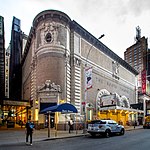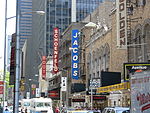Broadhurst Theatre

The Broadhurst Theatre is a Broadway theater at 235 West 44th Street in the Theater District of Midtown Manhattan in New York City. Opened in 1917, the theater was designed by Herbert J. Krapp and was built for the Shubert brothers. The Broadhurst Theatre is named for British-American theatrical producer George Broadhurst, who leased the theater before its opening. It has 1,218 seats across two levels and is operated by The Shubert Organization. Both the facade and the auditorium interior are New York City landmarks. The neoclassical facade is simple in design and is similar to that of the Schoenfeld (formerly Plymouth) Theatre, which was developed concurrently. The Broadhurst's facade is made of buff-colored brick and terracotta and is divided into two sections: a stage house to the west and the theater's entrance to the east. The entrance is topped by fire-escape galleries and contains a curved corner facing east toward Broadway. The auditorium contains an orchestra level, a large balcony, a small technical gallery, and a flat ceiling. The space is decorated in the classical Greek and Adam styles, with Doric columns and Greek friezes. Near the front of the auditorium, flanking the flat proscenium arch, are box seats at balcony level. The Shubert brothers developed the Broadhurst and Plymouth theaters following the success of the Booth and Shubert theaters directly to the east. The Broadhurst Theatre opened on September 27, 1917, with Misalliance; its namesake had intended to use the theater for his own productions. The Shuberts acquired full control of the Broadhurst in 1929 and have operated it since then. The theater has hosted not only musicals but also revues, comedies, and dramas throughout its history. Long-running shows hosted at the Broadhurst have included Hold Everything!, Fiorello!, Cabaret, Grease, Kiss of the Spider Woman, Les Misérables, and Mamma Mia!.
Excerpt from the Wikipedia article Broadhurst Theatre (License: CC BY-SA 3.0, Authors, Images).Broadhurst Theatre
West 44th Street, New York Manhattan
Geographical coordinates (GPS) Address External links Nearby Places Show on map
Geographical coordinates (GPS)
| Latitude | Longitude |
|---|---|
| N 40.7582 ° | E -73.9876 ° |
Address
Broadhurst Theatre
West 44th Street 235
10036 New York, Manhattan
New York, United States
Open on Google Maps











